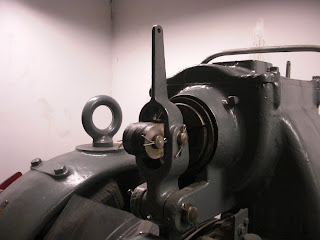Here's a picture of some of the motors. They're original Otis motors installed circa 1938 (note--just because it's Otis machinery doesn't mean my EM is an Otis employee):

This picture gives you an idea of how big they are:

Six cables are double wound around the sheave (pronounced "shiv"). One cable is strong enough to bear the weight of a car, but six cables are used for traction. My EM compared it to a dually truck--more tires equal better traction. To the right are the armature windings and on top are field coils. The coils are polarized. They energize and pull the armature in which ever direction it needs to go. Going up? Or down?

That's a brake plunger. There's one on the back side, too. When the motor stops, the core demagnetizes and pulls the metal plungers in. The spring puts pressure on the brakes, thus holding the elevator in place. The elevator never stops on these brakes, they just hold the car in place.

The red wheel holds the copper armature. Carbon brushes create voltage on the rotating copper which controls the car's leveling speed. As in, it tells the car to slow down as it approaches a floor.

The abrasive stoning brush is used to keep the copper armature clean. It's used like so whenever necessary, typically about ten minutes twice a year. That's an example of preventative maintenance.

This is where the bearing is housed. Gotta put oil up in that bitch:

That's the oil level. There's a chain that wraps around inside that carries oil around the shaft. Yes, the shaft must be well-lubed...

These are flyball governors, which, well, govern the speed of the cars. Using centrifugal force, or the principal of proportional control ... uh ...here's what Wikipedia says about flyball governors. But from what I gathered, when the wheels spin, the flyballs go higher, and if they go high enough, they trip an electric switch for the brake. If that doesn't work, the manual brake goes off, sets the safeties in the car and the mechanic has to manually reset the brakes. That rarely, if ever, happens.

But if it does happen, this is the key used to manually reset the brake. It's about two feet long.

The EM told me to make myself useful:

That's it for the machine room. Now we're off to peek around to see what's what from the roof. But first, this is the southbound view from the 45th floor. That's the Board of Trade building. The windows are covered in colored plastic sheets so it looks cool lit up at night. It makes for a strange inner atmosphere, though:

We pulled off the plastic sheet so I could get a close up of the goddess, Ceres. I know--it's not elevator-y. But it's very cool, and this is my adventure, so roll with it.

Going up on the roof wasn't very elevator-y, either. I had to take off my shoes to climb the metal ladder, which hurt my bare feet, but that's what I get for wearing cute shoes to this tour. Anyway, it was worth it to get these pictures.
Facing north:

Facing east:

Facing south:

Facing west:

After the exciting trip to the top of the building, we hopped in the freight elevator to go down to the sub-sub-basement. Stay tuned for the next installment of Nora Gets Shafted!



No comments:
Post a Comment